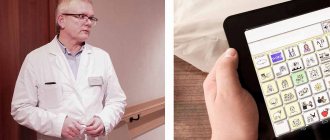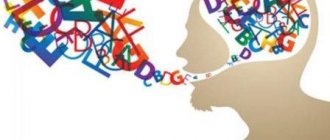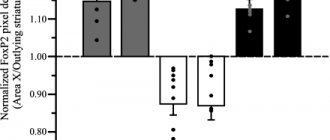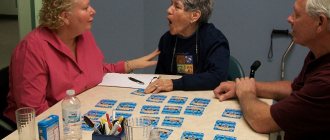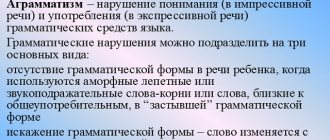Signs and causes of sensory aphasia
Sensory aphasia can result from a wide range of causes. This disease can be caused by both diseases of the cardiovascular system and traumatic injuries to the head and central nervous system. The most common causes of sensory aphasia are:
- Acute and transient disorders of cerebral blood flow, for example, embolism or hemorrhagic stroke. Embolization can occur as a result of the presence of an unstable atherosclerotic plaque in the bed of one of the carotid arteries or as a result of thrombus entry from the left atrial appendage in arthimogenic conditions.
- Traumatic head injuries, most often occurring in transport accidents. Contusions and traumatic brain injuries can lead to immediate damage to cortical and subcortical structures or delayed damage with the development of cerebral edema.
- Oncological processes localized in the cranium. Benign or malignant tumors can be a significant factor in the development of sensory aphasia.
It is important to note that the following branches entering the middle cerebral artery basin are most often involved in the formation of the lesion:
- Inferior branch of the middle cerebral artery;
- Posterior temporal artery;
- Artery of the angular gyrus.
How does sensory aphasia occur?
The reasons for the loss of the ability to speak connectedly lie in damage to the cortex of the temporal lobe of the brain. This may be a consequence:
- traumatic brain injuries;
- epilepsy;
- cerebral aneurysms;
- tumors;
- infections - encephalitis, meningitis and other diseases affecting the brain and its membranes;
- abscesses that arise as complications of otitis media or for other reasons;
- severe diseases accompanied by neurodegeneration or demyelination of nerve fibers;
- stroke.
The last two causes are extremely rare in children, but, unfortunately, they cannot be completely excluded.
Forms of sensory aphasia
There are several significant clinical forms of sensory aphasia that are characteristic of sensory aphasia. When additional pathological foci of the cortical substance join the affected Wernicke's area, new symptoms of impaired speech function appear. In this regard, neurologists distinguish the following forms of aphasia:
Semantic aphasia
With this aphasia, there is a violation of the recognition of logic and the relationship of words and objects. This is especially true for spatial perception.
Acalculia-aphasia
In this case, the key symptom is the formation of a localized disorder of speech function. Namely, counting violations. At the same time, the patient’s other forms of speech are not affected.
Sensorimotor aphasia
Lack of speech awareness is associated not only with damage to the cortical part of the auditory analyzer, but also with a violation of articulatory function. In other words, a person cannot correctly evaluate gestures when pronouncing a specific word like another person. Same with myself. The patient himself is not aware of his illness and is very irritated in situations where he is not understood.
Total aphasia
With this option, the victim has a combination of different types of functional speech disorder. The patient has impairments in written and oral speech. In this case, the patient does not perceive someone else’s speech and also cannot answer anything himself.
Aphasia
Regardless of the mechanism, with any form of aphasia, speech impairment in general is observed. This is due to the fact that the primary loss of one or another aspect of the speech process inevitably entails a secondary collapse of the entire complex functional system of speech.
Motor aphasia
Due to the difficulty of switching from one speech element to another, numerous rearrangements of sounds and syllables, perseverations, literal paraphasias, and contaminations are observed in the speech of patients with efferent motor aphasia. Characterized by a “telegraphic style” of speech, long pauses, hypophonia, and a violation of the rhythmic and melodic aspects of speech. The pronunciation of individual sounds in efferent motor aphasia is not impaired. The disintegration of the ability to sound-letter analysis of a word is accompanied by severe reading and writing impairments (dyslexia/alexia, dysgraphia/agraphia).
Afferent motor aphasia can occur in two ways. In the first option, there is articulatory apraxia or a complete absence of spontaneous speech, the presence of a speech embolus. In the second option, conduction aphasia, situational speech remains intact, but repetition, naming and other types of voluntary speech are grossly impaired. With afferent motor aphasia, phonemic hearing and, consequently, the understanding of spoken language, the meanings of individual words and instructions, as well as written speech are secondarily impaired.
Sensory aphasia
Unlike motor aphasia, with acoustic-gnostic (sensory) aphasia, the auditory perception of speech is impaired with normal physical hearing. With Wernicke's aphasia, the patient does not understand the speech of others and does not control his own speech flow, which is accompanied by the development of compensatory verbosity. In the first 1.5-2 months. after a brain catastrophe, the speech of patients includes a random set of sounds, syllables and words (“speech okroshka” or jargonphasia), so its meaning is unclear to others. Then jargonaphasia gives way to verbosity (logorrhea) with pronounced agrammatisms, literal and verbal paraphasias. Since in sensory aphasia phonemic hearing is primarily affected, writing is impaired; reading remains the most intact because it relies more on optical and kinesthetic control.
Acoustic-mnestic aphasia
With acoustic-mnestic aphasia, patients have difficulty retaining information perceived auditorily in memory. At the same time, the volume of memorization is significantly reduced: the patient cannot repeat a bunch of 3-4 words after the speech therapist, does not grasp the meaning of speech in complicated conditions (long phrase, fast pace, conversation with 2-3 interlocutors). Difficulties in speech communication in acoustic-mnestic aphasia are compensated by increased speech activity. With optical-mnestic aphasia, there is a violation of visual memory, a weakening of the connection between the visual image of an object and a word, and difficulties in naming objects. Disorders of auditory-verbal and visual memory entail a violation of writing, understanding of readable text, and counting operations.
Semantic aphasia
Amnestic-semantic aphasia is manifested by forgetting the names of objects (anomia); impaired understanding of complex speech patterns reflecting temporal, spatial, cause-and-effect relationships; participial and participial phrases, proverbs, metaphors, catchphrases, figurative meaning, etc. Also, with semantic aphasia, acalculia is noted, and understanding of the text being read is impaired.
Dynamic aphasia
With dynamic aphasia, despite the correct pronunciation of individual sounds, words and short phrases, preserved automated speech and repetition, spontaneous narrative speech becomes impossible. Verbal activity is sharply reduced, and echolalia and perseveration are present in the speech of patients. Reading, writing and basic counting remain intact in dynamic aphasia.
Symptoms
Clinical manifestations of sensory aphasia have a number of specific signs that help make a quick and effective differential diagnosis. These signs include:
- Fluent speech or logorrhea, replete with a large number of allegorical expressions and paraphrases. The patient misses nouns, and I compensate for such speech defects with a large number of verbs, prepositions and conjunctions. Speech becomes verbose, but uninformative.
- “Jargnonic aphasia” is a continuous stream of neologisms, proverbs, sayings and paraphrases.
- Strong excitement up to the development of a paranoid state.
- Impaired understanding and perception of speech. The patient has difficulty or does not perceive simple questions at all, for example, a request to introduce himself or say who he is, but is able to follow simple commands, for example, turn his head or introduce himself. It is also important to note that the patient does not understand his own problem and becomes very irritated when the interlocutor does not perceive his speech well.
- Right-sided hemianopsia or upper quadrant hemianopsia. Loss of visual fields - when reading books, the victim will completely not notice the left page when reading the text.
- Smoothing of the nasolabial fold - the face becomes like a mask.
- Impairment of written speech.
There is also pure sensory aphasia (subcortical), when only the understanding of oral speech is impaired, but the understanding of written information, and therefore what is read, is preserved. Another form is also distinguished - transcortical sensory aphasia, which is characterized by the preservation of the ability to repeat oral speech, despite the lack of its perception and understanding. The main problem is that the patient hears the address to himself, but cannot interpret the meaning of what the interlocutor said. The native language is perceived as if it were foreign.
Sensory aphasia in rare cases occurs as an independent lesion of the auditory zones located in the brain, since in almost 85% of cases the damage involves several areas of the brain responsible for a wide variety of functions of the victim’s body. For example, with a stroke, sensory aphasia is often combined with paresis or paralysis of skeletal muscles on the side opposite the lesion. In the case of an infectious-inflammatory process: abscess, meningitis, encephalitis, there will be signs of general intoxication of the body and febrile syndrome, as well as cerebral symptoms. In the case of encephalitis, specific changes will be added to the cerebrospinal fluid - cerebrospinal fluid.
Specific signs of sensory aphasia in children
Sensory aphasia in childhood can be confused with alalia - the primary absence of speech, but there is a difference: if with alalia speech does not shift from the initial level of development, i.e. does not progress and does not undergo regression, then with aphasia a sharp degradation in the development of speech function, which has already been formed in a person, is noticeable. Since in childhood the speech function is not yet fully formed, there are specific signs for aphasia:
- As a rule, there is a rapid development of the disease and rapid recovery of speech function. Lack of recovery progress over several weeks is a poor prognostic sign for further recovery and indicates more serious brain damage.
- Restoration of speech function is carried out by increasing the activity of neighboring areas of the cortex, which to some extent are able to compensate for the neurological deficit. In adults, the restoration of speech function is carried out due to the formation of new logical connections and a developed conceptual apparatus.
- Scanty symptoms. Very often, it is difficult to determine the specific type of aphasia in children, since their speech function is not sufficiently developed. As a result, the conditions for revealing the full clinical picture of sensory aphasia are not created.
Treatment of aphasia in Saratov, Russia
At your first consultation you will receive information about the treatment of aphasia and the following questions. Semantic and traumatic aphasia. How does speech restoration occur in aphasia? How does speech sound in patients with aphasia? What is optic-mnestic aphasia, afferent and efferent aphasia, dynamic acoustic-gnostic and acoustic-mnestic kinesthetic aphasia? How are stroke (a condition after a stroke), alalia, agnosia, apraxia and aphasia disease related and how do they differ? How are patients examined and speech therapy work done for aphasia? Why do you need an aphasia speech map? What exercises should you do for aphasia?
Sign up for a consultation. There are contraindications. Specialist consultation is required.
Photo: Santos06 | Dreamstime.com\Dreamstock.ru. The people depicted in the photo are models, do not suffer from the diseases described and/or all similarities are excluded.
Related posts:
Dyslalia in children, characteristics, forms, correction, treatment
Alalia for children, alalia treatment, motor, sensory, sensorimotor
Tics, nervous tics, treatment, hyperkinesis, hyperkinesis treatment
Headache in children, treatment, how to get rid of it, how to relieve it
Yactation, rocking, nodding movements of the head, torso, body
Comments ()
Diagnostics
Diagnosis of sensory aphasia is primarily aimed at identifying the cause of the disease. The diagnostic study must be comprehensive and consist of the following stages:
- Consultation and questioning of the patient to determine the history of life and illness. Also, during the initial appointment, the doctor examines the patient and studies specific symptom complexes. The neurologist looks for concomitant diseases that manifest themselves not only by external signs, but also by conducting additional tests and studies. During the examination, a specialist neurologist determines the lesions, the nature and course of the pathological process, assesses the general condition of the patient, as well as the blood supply to the brain. Makes a prognosis and subsequent treatment plan in accordance with the patient’s age. Its individual characteristics and concomitant somatic diseases. As well as the level of damage to the central nervous system.
- Consultation with a speech therapist, psychologist and other specialists. They determine the severity of the speech function defect and coordinate further tactics for restoring lost functions with the attending physician.
- Conducting additional instrumental and laboratory studies to verify and clarify the clinical diagnosis. Studies such as computer and magnetic resonance imaging, electroencephalography, angiography of cerebral vessels are carried out. These studies are carried out to identify the level and area of brain damage, the presence of space-occupying formations in the nervous tissue, aneurysms and hemorrhages in the brain tissue, foci of abscess, and the consequences of a stroke.
Treatment
The treatment process aimed at restoring the consequences resulting from aphasia requires a long time and enormous dedication, both from the patient and his relatives, and from medical personnel and specialists who have undergone special training. The restoration work of such a pathological condition consists of the following points:
- Pharmacological (drug) therapy. It mainly includes the use of drugs from the group of nootropics, drugs that increase the metabolism and trophic potential of the brain, vitamin therapy with neuroprotective B vitamins. Additional therapy is selected individually and prescribed in accordance with the cause of sensory aphasia. For example, in the case of a stroke, thrombolytic or hemostatic drugs are added, in the case of an infectious inflammatory lesion, antibiotics, non-steroidal anti-inflammatory drugs or antifungal agents are added.
- Session with a speech therapist. The main difficulty that arises when attempting to contact the victim is the lack of understanding of the specialist’s approach to the patient. Violation of communicative activity requires long-term correction and perseverance. There are also difficulties in interpreting what the patient says. Because his speech is uninformative. It is very difficult to identify the main idea. Consultations with a speech therapist help restore the patient’s vocabulary, correct pronunciation of sounds and meaningful speech. With the help of special exercises and equipment, you can actively interact with the patient even at home.
- Surgical interventions. In some cases, with deep or severe brain damage, the patient requires emergency surgery to eliminate the threat to life. In case of an aneurysm, clipping or sclerosis of the aneurysm can be performed using X-ray control. If aphasia is caused by tumor growth, then stereotactic surgery can be performed to destroy the tumor focus.
- Additional treatment methods can speed up the recovery processes in the victim’s nervous tissue, and also increase the effectiveness of the main therapy. In the treatment of sensory aphasia, methods such as physical therapy, massage, physiotherapeutic methods, and the use of computer programs that stimulate the speech center and improve speech abilities are used. A positive effect has also been noted in contact with animals, so the following can be used in therapy: hippotherapy, feline therapy and dolphin therapy.
At the Clinical Institute of the Brain there is a specialized rehabilitation and recovery center that deals with the correction of disorders in patients with aphasia. Together with treatment, we manage to achieve a quick, step-by-step recovery process. There is a close connection between treatment and rehabilitation, which helps to quickly adapt the patient to new living conditions, thereby significantly increasing the effectiveness of therapy and recovery.
2.3.4. Sensory aphasia
Damage to the posterior third of the superior temporal gyrus (Brodmann's 22nd area - Wernicke's area) is accompanied by a violation of phonemic hearing, which leads to a defect in the acoustic perception of the sound composition of a word, i.e., to a violation of the first link in the structure of understanding - the sound discrimination link. The sound of a word loses its constancy and stability; therefore, understanding, as well as repetition and pronunciation of words becomes almost impossible due to defects in sound discrimination, i.e., acoustic analysis and synthesis of sounds. Impairment of phonemic hearing is the central mechanism, the factor underlying sensory aphasia, the central defect of which is a violation of speech understanding. In the clinical picture, this defect manifests itself in the “phenomenon of alienation of the meaning of words,” in a violation of the understanding of words, instructions, and spoken speech. There is an abundance of literal paraphasia in oral speech (replacement of one sound with another in spoken words: cucumber - okulet, tomato - bopiton, house - tom, etc.). This group of patients differs sharply in both general and verbal behavior from the patients with lesions of the anterior speech zone described above. Patients with sensory aphasia are sociable; they compensate for the deficit of verbal means of communication with paralinguistic methods: facial expressions, gestures, intonation. If in patients with damage to the anterior speech zone the prosody of speech is impaired, then in sensory aphasia it is more preserved. Oral expressive spontaneous speech is little or completely unproductive, in severe cases it manifests itself as the phenomenon of “jargonaphasia,” which is characterized by disorganized speech, consisting of a set of unrelated various elements of speech or their parts, contamination, literal and verbal paraphasia. The speech is also incoherent in grammatical form. Often in such disorganized speech there are correctly pronounced words, but they occur without awareness on the part of the patient. Repetition is grossly impaired: patients are practically unable to correctly repeat a single sound or word. Qualitative analysis of errors indicates their phonemic nature: replacements of oppositional sounds occur. By the same mechanism, the naming of objects is also impaired: patients, knowing the object and its name, cannot find the necessary phonetic, sound structure of it. For them, the objective attribution of the word is also disrupted due to the collapse of its sound structure, one of the most important material carriers of the word. These patients are characterized by repeated attempts at repetition, naming, and in general they are distinguished by verbosity (or logorrhea). Their speech is emotionally colored and richly intonated. Impaired speech understanding begins with a lack of understanding of the simplest instructions. However, they can grasp the overall meaning of the statement. The psychological level of understanding, at which the general meaning is extracted, is more preserved in them than the lexico-grammatical level, in which the sound discrimination link is grossly disrupted due to defects in the acoustic analysis of speech sounds at the sensorimotor level. If patients with sensory aphasia are given a context and the topic of the conversation is determined, the level of understanding increases sharply.
The sensory aphasia syndrome includes disorders of: 1) oral expressive speech, all its types; 2) reading; 3) letters; 4) oral counting (hearing) due to defects in sound analysis. The sensory aphasia syndrome includes disturbances in the assessment and reproduction of rhythm (rhythmic tapping - //… //… //; ///… ///… ///; //…//…; etc.), disturbances in the emotional sphere — patients are anxious, their emotional reactions are unstable.
The psychological picture of speech impairment reveals a violation of almost all speech functions, except for its emotional and expressive components. The meaning of the word is violated, it is often replaced by meaning, but not always accurate. The level of verbal generalizations is also reduced. All mental processes not associated with acoustic gnosis remain intact - all types of praxis, visual perception and spatial orientation, written counting and counting operations.
2.3.3. Afferent motor aphasia – Previous | The next one is 2.3.5. Acoustic-mnestic aphasia
Rehabilitation
Only daily classes with a speech therapist and other specialists will contribute to an active rehabilitation process. It is very important to correctly build a rehabilitation plan from simple to complex. To begin with, the victim must be adapted to new conditions. Only after a course of psychotherapy can one begin rehabilitation measures, since the patient must be motivated to recover.
The patient can also perform the following exercises at home:
- Simple questions: the patient is first asked questions with monosyllabic yes or no answers, then later they move on to open questions.
- Thematic dialogues are practiced with the gradual development of dialogue on specific topics;
- Writing and reading. Correction of the spelling and pronunciation of letters begins. Then syllables, which the patient then puts into words. In the future, with successful progress, they move on to writing dictations and reading short texts. The patient is asked to retell in his own words the story he read and answer questions about its content;
- A task aimed at matching pictures and text. The patient is asked to build a story, while laying out the pictures sequentially;
- Structuring pictures according to general properties and characteristics. The patient is given the task of arranging the pictures according to categories and highlighting common characteristics, for example, to separate some animals from others.
Clinical Brain Institute Rating: 4/5 — 12 votes
Share article on social networks
Treatment of aphasia
Before correcting speech disorders, specialists determine the cause of the disease and, if possible, eliminate it. The therapy itself consists of:
- Work with a speech therapist and neurologist. The doctor individually selects a treatment program: teaches how to pronounce or isolate individual sounds in words, and relate objects and their names. To understand speech, simple exercises are used, for example, patients must use gestures to give a positive or negative answer to a simple question (“Is the door closed?”, “Is the lemon yellow?”), perform a simple action (“Wave your hand,” “Take a book”), find an error in a sentence (“The man slept in the car, the man rode in the bed”, “I opened it with a book”). In case of memory impairment, the patient is read a short text and then asked to retell it. Over time, the task becomes more difficult. Articulation gymnastics restores speech well. It is important that the speech of the patient and specialist is calm, clear and slow; you should not use long, complex constructions.
- Physiotherapy. The doctor selects a program of procedures, which may include exercise therapy, physiotherapy, massage, etc.
- Taking medications.
In rare cases, surgery is required.
Rehabilitation can last several years, and in some situations the patient completely restores speech. The success of treatment depends on many factors: the severity of the disease, the individual characteristics of the patient. The sooner a patient consults a doctor, the greater the likelihood of a complete recovery.
All conditions have been created for the rehabilitation to be successful, and the results to be even higher than expectations. We adhere to a multidisciplinary approach: doctors of different specializations take part in treatment. Respectful attitude towards patients, competent work of a psychologist, and a cozy homely atmosphere play a big role in recovery.
Programs:
Stroke Prevention
Outpatient diagnostic
Rehabilitation programs
Diagnosis of swallowing disorders and correction
Restoration and correction of speech disorders
